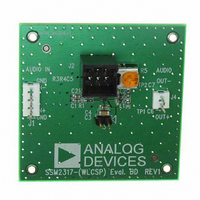SSM2317-EVALZ Analog Devices Inc, SSM2317-EVALZ Datasheet - Page 14

SSM2317-EVALZ
Manufacturer Part Number
SSM2317-EVALZ
Description
BOARD EVAL SSM2317
Manufacturer
Analog Devices Inc
Datasheet
1.SSM2317CBZ-REEL7.pdf
(20 pages)
Specifications of SSM2317-EVALZ
Amplifier Type
Class D
Output Type
1-Channel (Mono)
Max Output Power X Channels @ Load
3.89W x 1 @ 3 Ohm
Voltage - Supply
2.5 V ~ 5.5 V
Operating Temperature
-40°C ~ 85°C
Board Type
Fully Populated
Utilized Ic / Part
SSM2317
Silicon Manufacturer
Analog Devices
Application Sub Type
Audio Power Amplifier - Class D
Kit Application Type
Amplifier
Silicon Core Number
SSM2317
Kit Contents
Board
Lead Free Status / RoHS Status
Lead free / RoHS Compliant
SSM2317
THEORY OF OPERATION
OVERVIEW
The SSM2317 mono Class-D audio amplifier features a filterless
modulation scheme that greatly reduces the external components
count, conserving board space and, thus, reducing systems cost.
The SSM2317 does not require an output filter but instead relies
on the inherent inductance of the speaker coil and the natural
filtering of the speaker and human ear to fully recover the audio
component of the square wave output. Most Class-D amplifiers
use some variation of pulse-width modulation (PWM), but the
SSM2317 uses a Σ-Δ modulation to determine the switching
pattern of the output devices, resulting in a number of impor-
tant benefits. Σ-Δ modulators do not produce a sharp peak with
many harmonics in the AM frequency band, as pulse-width
modulators often do. Σ-Δ modulation provides the benefits of
reducing the amplitude of spectral components at high frequencies,
that is, reducing EMI emission that might otherwise be radiated
by speakers and long cable traces. Due to the inherent spread
spectrum nature of Σ-Δ modulation, the need for oscillator
synchronization is eliminated for designs incorporating multiple
SSM2317 amplifiers.
The SSM2317 also offers protection circuits for overcurrent and
temperature protection.
GAIN
The SSM2317 has a default gain of 18 dB that can be reduced by
using a pair of external resistors with a value calculated as follows:
POP-AND-CLICK SUPPRESSION
Voltage transients at the output of the audio amplifiers can
occur when shutdown is activated or deactivated. Voltage
transients as low as 10 mV can be heard as an audio pop in the
speaker. Clicks and pops can also be classified as undesirable
audible transients generated by the amplifier system and,
therefore, as not coming from the system input signal. Such
transients can be generated when the amplifier system changes its
operating mode. For example, the following can be sources of
audible transients: system power-up/power-down, mute/unmute,
input source change, and sample rate change. The SSM2317 has a
pop-and-click suppression architecture that reduces these
output transients, resulting in noiseless activation and
deactivation.
OUTPUT MODULATION DESCRIPTION
The SSM2317 uses three-level, Σ-Δ output modulation. Each
output can swing from GND to VDD and vice versa. Ideally,
when no input signal is present, the output differential voltage is
0 V because there is no need to generate a pulse. In a real-world
situation, there are always noise sources present. Due to this
constant presence of noise, a differential pulse is generated,
when required, in response to this stimulus. A small amount of
current flows into the inductive load when the differential pulse
is generated.
External Gain Settings = 80 kΩ/(10 kΩ + R
EXT
)
Rev. A | Page 14 of 20
However, most of the time, output differential voltage is 0 V,
due to the Analog Devices, Inc., patented three-level, Σ-Δ
output modulation. This feature ensures that the current
flowing through the inductive load is small.
When the user wants to send an input signal, an output pulse
is generated to follow the input voltage. The differential pulse
density is increased by raising the input signal level. Figure 41
depicts three-level, Σ-Δ output modulation with and without
input stimulus.
Figure 41. Three-Level, Σ-Δ Output Modulation With and Without Input Stimulus
LAYOUT
As output power continues to increase, care must be taken
to lay out PCB traces and wires properly among the amplifier,
load, and power supply. A good practice is to use short, wide
PCB tracks to decrease voltage drops and minimize inductance.
Ensure that track widths are at least 200 mil for every inch of
track length for lowest DCR, and use 1 oz or 2 oz of copper PCB
traces to further reduce IR drops and inductance. A poor layout
increases voltage drops, consequently affecting efficiency. Use
large traces for the power supply inputs and amplifier outputs
to minimize losses due to parasitic trace resistance.
Proper grounding guidelines help improve audio performance,
minimize crosstalk between channels, and prevent switching
noise from coupling into the audio signal. To maintain high
output swing and high peak output power, the PCB traces that
connect the output pins to the load and supply pins should be as
wide as possible to maintain the minimum trace resistances. It
is also recommended that a large ground plane be used for
minimum impedances.
In addition, good PCB layouts isolate critical analog paths from
sources of high interference. Separate high frequency circuits
(analog and digital) from low frequency circuits.
Properly designed multilayer PCBs can reduce EMI emission
and increase immunity to the RF field by a factor of 10 or more,
OUT+
OUT–
OUT+
OUT–
OUT+
OUT–
V
V
V
OUT
OUT
OUT
OUTPUT = 0V
OUTPUT > 0V
OUTPUT < 0V
+5V
0V
+5V
0V
+5V
0V
–5V
+5V
0V
+5V
0V
+5V
0V
+5V
0V
+5V
0V
0V
–5V













